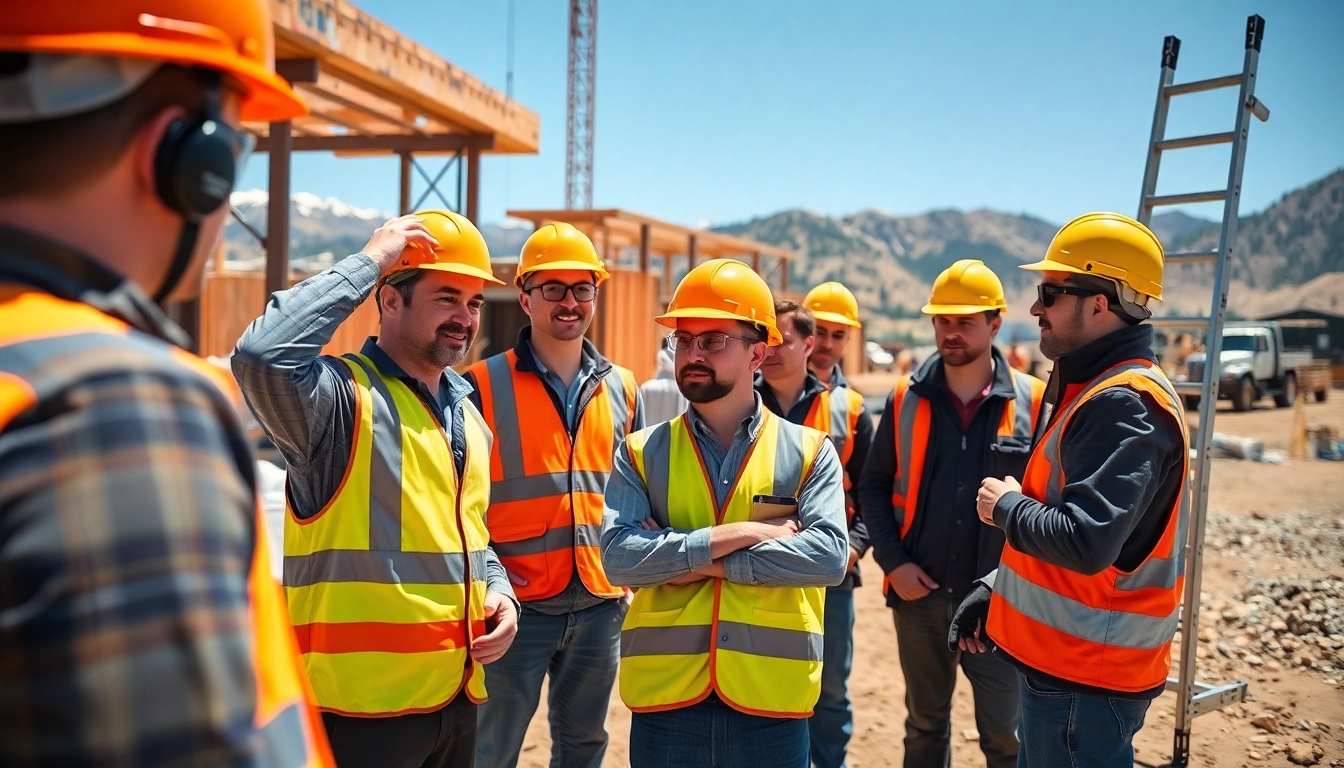Understanding the Importance of Construction Safety Training Colorado
In the construction industry, safety training is not just a regulatory requirement; it is a vital component of promoting a safe working environment. With numerous activities involving heavy machinery, hazardous materials, and complex working conditions, the risks can be significantly high. That’s why investing in construction safety training colorado becomes imperative for both employers and employees. By ensuring comprehensive training programs, we can mitigate risks associated with construction jobs, protect workers, and promote a culture of safety on-site.
Why Safety Training is Critical in Construction
The construction industry is one of the most dangerous fields to work in. According to data from the Occupational Safety and Health Administration (OSHA), construction workers account for a significant percentage of workplace accidents and fatalities. Safety training serves several critical functions:
- Accident Prevention: Training empowers workers with the knowledge and skills to recognize hazards, thereby preventing accidents.
- Compliance: It ensures that organizations meet regulatory requirements set by OSHA and other governing bodies.
- Improving Workforce Morale: Providing safety training shows that the organization values employee safety, which can enhance overall job satisfaction and productivity.
- Reducing Costs: Fewer accidents lead to lower insurance premiums, reduced liability, and less downtime due to injuries.
Regulatory Requirements for Training in Colorado
In Colorado, employers must adhere to specific regulations concerning safety training. OSHA outlines several requirements, including:
- All employers must provide a workplace free from recognized hazards that cause or are likely to cause death or serious physical harm.
- Workers must be trained to recognize and avoid unsafe conditions, especially those caused by machinery, tools, or hazardous materials.
- Employers are required to maintain records of training provided to employees.
Understanding these requirements is critical for compliance, both to avoid legal ramifications and to foster a culture of safety within the workforce.
Common Hazards in Construction and Mitigation Strategies
Construction sites are rife with potential hazards, which can vary depending on the project type and the environment. Some of the most common hazards include:
- Falls: Often cited as the leading cause of fatalities in construction, falls can be mitigated through proper training in fall protection measures and using personal protective equipment (PPE).
- Electrical Hazards: Workers must be trained to understand electrical systems and recognize potential hazards, such as live wires and improper grounding.
- Struck-by and Caught-in/Between Hazards: These can occur when workers are struck by falling objects or caught in machinery. Strategies include using barriers and ensuring proper signaling and communication.
- Hazardous Materials: Training around the handling of materials like asbestos, lead, and silica is critical. Understanding the risks and proper handling techniques is vital.
By addressing these hazards through targeted training and risk assessments, employers can significantly reduce the likelihood of accidents.
Key Components of Effective Safety Training Programs
Curriculum Essentials: Topics and Skills
A robust safety training program should encompass a range of topics to equip workers with essential skills. Key areas include:
- Hazard Recognition: Employees should be able to identify potential hazards on the job site.
- Emergency Response: Training should include protocols for responding to emergencies, such as fires or medical emergencies.
- Use of Personal Protective Equipment: Workers must understand how to properly use and maintain their PPE.
- Specific Safety Protocols: Depending on the job, specialized training may be necessary (e.g., scaffolding safety, trenching, etc.).
Hands-On Training: Importance and Methods
Theoretical knowledge alone is often not enough; hands-on training is crucial for effective learning. Methods for delivering this type of training can include:
- Simulations: Realistic simulations help workers practice their responses to potential hazards.
- Workshops: Interactive workshops foster engagement and allow for practical experience with equipment and procedures.
- On-the-Job Training: Pairing less experienced workers with seasoned professionals allows for mentoring and real-time learning opportunities.
Hands-on training solidifies learning and ensures that employees are adequately prepared for real-world situations on site.
Evaluating Training Outcomes and Effectiveness
To ensure that training programs are effective, regular evaluation is essential. Employers should consider:
- Employee Feedback: Collecting input from employees can highlight areas of improvement in the training program.
- Performance Metrics: Measuring incident rates before and after training can provide insight into the effectiveness of the curriculum.
- Refresher Courses: Regular updates and additional training ensure that knowledge remains current, especially in an ever-evolving industry.
Finding the Right Construction Safety Training Colorado Providers
Accreditations and Certifications to Look For
When selecting a training provider, it’s essential to verify their credentials. Look for providers that have:
- OSHA Compliance: Ensure that the provider adheres to all federal and state OSHA standards.
- Accreditations: Look for programs that are certified by reputable organizations in the industry.
- Experienced Instructors: Trainers should have relevant industry experience and credentials to ensure quality instruction.
Comparing Training Delivery Options: In-Person vs. Online
Employers should explore the delivery methods of training programs. Both in-person and online training have their advantages:
- In-Person Training: Offers immediate feedback and the ability to practice in a controlled environment.
- Online Training: Provides flexibility and accessibility, allowing employees to learn at their own pace.
Ultimately, the best approach may be a hybrid model that incorporates both methods to maximize learning effectiveness.
Cost Considerations for Construction Safety Training
Budgeting for safety training is crucial. Consider costs associated with:
- Training Program Fees: Analyze the total cost of the training programs depending on the topics offered.
- Employee Time Off: Factor in costs associated with taking employees off projects for training sessions.
- Potential Savings on Insurance and Liability: Highlighting the long-term financial benefits of investing in training can help justify upfront costs.
Implementing a Safety Culture in Construction Teams
Leadership’s Role in Promoting Safety
Creating a culture of safety requires strong leadership commitment. Leaders should:
- Model Safe Practices: Leaders set the tone by practicing safe behaviors and prioritizing safety in their decisions.
- Communicate Openly: Fostering an environment where employees feel comfortable reporting hazards or unsafe conditions is vital.
- Provide Resources: Ensure that employees have access to the necessary tools, training, and information to work safely.
Encouraging Employee Engagement in Safety Practices
Active employee participation enhances safety initiatives. To foster engagement, consider:
- Involve Employees in Training Development: Seek input on the training curriculum to address their specific concerns and experiences.
- Recognize Safe Practices: Implement reward programs for teams that demonstrate exemplary safety compliance.
- Regular Safety Meetings: Hold meetings to discuss safety issues and encourage open forums for sharing ideas and suggestions.
Monitoring and Reporting Safety Compliance
Ongoing monitoring is key to maintaining safety standards. This can include:
- Regular Inspections: Conduct safety audits to ensure compliance with regulations and identify areas for improvement.
- Incident Reporting Systems: Establish clear procedures for reporting accidents, near misses, and unsafe conditions.
- Continuous Training Updates: Update training materials as regulations and industry standards change to keep all personnel informed.
Future Trends in Construction Safety Training Colorado
Innovations in Training Technologies
Emerging technologies are revolutionizing safety training across the construction industry. Future innovations may include:
- Virtual Reality Simulations: VR can provide workers with immersive training experiences, allowing them to practice scenarios in a safe environment.
- Mobile Learning Platforms: Mobile apps can facilitate on-the-go learning, making safety training accessible directly on job sites.
- Data Analytics: Utilizing data to track training effectiveness and worker safety compliance can enable organizations to adapt their strategies more efficiently.
Adapting to Changes in Regulation and Industry Standards
As regulation evolves, construction companies must ensure their training programs remain compliant. Strategies may include:
- Staying Informed: Regularly reviewing updates from OSHA and local regulatory bodies ensures compliance.
- Continuing Education: Encourage ongoing education to adapt to new rules and technologies that enhance worker safety.
Case Studies of Successful Safety Programs
Examining successful safety training programs can provide valuable insights. Organizations recognized for their exemplary safety records often implement:
- Comprehensive Training: Programs that cover a broad array of safety topics lead to higher employee satisfaction and reduced incidents.
- Adaptive Learning Models: Tailoring safety training to the specific site conditions and employee needs often results in higher engagement levels.
- Strong Leadership Support: When leadership prioritizes safety as a core value, it creates an environment that encourages continuous improvement and accountability.


